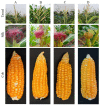Improvement of a Yairipok Chujak Maize Landrace from North Eastern Himalayan Region for β-Carotene Content through Molecular Marker-Assisted Backcross Breeding
- PMID: 34069791
- PMCID: PMC8157291
- DOI: 10.3390/genes12050762
Improvement of a Yairipok Chujak Maize Landrace from North Eastern Himalayan Region for β-Carotene Content through Molecular Marker-Assisted Backcross Breeding
Abstract
In the North Eastern Himalayan region (NEHR) of India, maize is an important food crop. The local people cultivate the maize landraces and consume them as food. However, these landraces are deficient in β-carotene content. Thus, we aimed to incorporate the crtRB1 gene from UMI285β+ into the genetic background of the NEHR maize landrace, Yairipok Chujak (CAUM66), and thereby enhance the β-carotene content through marker-assisted backcrossing (MABC). In this regard, we backcrossed and screened BC1F1 and BC2F1 plants possessing the heterozygous allele for crtRB1 and then screened with 106 polymorphic simple sequence repeat (SSR) markers. The plants having maximum recurrent parent genome recovery (RPGR) were selected in each generation and selfed to produce BC2F2 seeds. In the BC2F2 generation, four plants (CAUM66-54-9-12-2, CAUM66-54-9-12-11, CAUM66-54-9-12-13, and CAUM66-54-9-12-24) having homozygous crtRB1-favorable allele with maximum RPGR (86.74-90.16%) were selected and advanced to BC2F3. The four selected plants were selfed to produce BC2F3 and then evaluated for agronomic traits and β-carotene content. The agronomic performance of the four lines was similar (78.83-99.44%) to that of the recurrent parent, and β-carotene content (7.541-8.711 μg/g) was on par with the donor parent. Our study is the first to improve the β-carotene content in NEHR maize landrace through MABC. The newly developed lines could serve as potential resources to further develop nutrition-rich maize lines and could provide genetic stock for use in breeding programs.
Keywords: CAUM66 (Yairipok Chujak); MABC; North Eastern Himalayan region; crtRB1.
Conflict of interest statement
All authors declare that they have no conflict of interest. This article does not contain any studies with human participants or animals performed by the author.
Figures



Similar articles
-
Marker-Assisted Selection to Pyramid the Opaque-2 (O2) and β-Carotene (crtRB1) Genes in Maize.Front Genet. 2019 Sep 26;10:859. doi: 10.3389/fgene.2019.00859. eCollection 2019. Front Genet. 2019. PMID: 31611905 Free PMC article.
-
Development of β-carotene, lysine, and tryptophan-rich maize (Zea mays) inbreds through marker-assisted gene pyramiding.Sci Rep. 2022 May 20;12(1):8551. doi: 10.1038/s41598-022-11585-y. Sci Rep. 2022. PMID: 35595742 Free PMC article.
-
Development of sub-tropically adapted diverse provitamin-A rich maize inbreds through marker-assisted pedigree selection, their characterization and utilization in hybrid breeding.PLoS One. 2021 Feb 4;16(2):e0245497. doi: 10.1371/journal.pone.0245497. eCollection 2021. PLoS One. 2021. PMID: 33539427 Free PMC article.
-
Marker-assisted selection to improve drought adaptation in maize: the backcross approach, perspectives, limitations, and alternatives.J Exp Bot. 2007;58(2):351-60. doi: 10.1093/jxb/erl214. Epub 2006 Dec 6. J Exp Bot. 2007. PMID: 17158111 Review.
-
Successes and insights of an industry biotech program to enhance maize agronomic traits.Plant Sci. 2021 Jun;307:110899. doi: 10.1016/j.plantsci.2021.110899. Epub 2021 Mar 30. Plant Sci. 2021. PMID: 33902858 Review.
Cited by
-
Multi-omics revolution to promote plant breeding efficiency.Front Plant Sci. 2022 Dec 8;13:1062952. doi: 10.3389/fpls.2022.1062952. eCollection 2022. Front Plant Sci. 2022. PMID: 36570904 Free PMC article.
-
Marker-Assisted Backcross Breeding of Drought-Tolerant Maize Lines Transformed by Vacuolar H+-Pyrophosphatase Gene (AnVP1) from Ammopiptanthus nanus.Plants (Basel). 2025 Mar 15;14(6):926. doi: 10.3390/plants14060926. Plants (Basel). 2025. PMID: 40265817 Free PMC article.
-
Omics-Facilitated Crop Improvement for Climate Resilience and Superior Nutritive Value.Front Plant Sci. 2021 Dec 1;12:774994. doi: 10.3389/fpls.2021.774994. eCollection 2021. Front Plant Sci. 2021. PMID: 34925418 Free PMC article. Review.
-
Applications and Prospects of CRISPR/Cas9-Mediated Base Editing in Plant Breeding.Curr Issues Mol Biol. 2023 Jan 19;45(2):918-935. doi: 10.3390/cimb45020059. Curr Issues Mol Biol. 2023. PMID: 36826004 Free PMC article. Review.
References
-
- Food and Agricultural Organization of the United Nations FAO STAT. Import and Export Value of Maize. [(accessed on 2 February 2021)]; Available online: http://www.fao.org/faostat/en/#rankings/countries_by_commodity.
-
- Natesan S., Singh T., Duraisamy T., Chandrasekharan N., Chandran S., Adhimoolam K., Muniyandi S., Sampathrajan V., Kalipatty Nalliappan G., Muthurajan R. Characterization of crtRB1 Gene Polymorphism and and β carotene content in Maize Landrances Originated from North Eastern Himalayan Region (NEHR) of India. Front. Sustain. Food Syst. 2020 doi: 10.3389/fsufs.2020.00078. - DOI
-
- Saha S., Lungmuana D., Ansari M., Jat S., Chowdhury S., Saithantluanga H., Rakshit S., Prakash N. Souvenir of National Workshop on Scientific Maize Cultivation in North East India held on 5 March, 2019 at SAMETI Training Hall, Aizawl, Mizoram. [(accessed on 8 March 2021)]; Available online: https://krishi.icar.gov.in/jspui/handle/123456789/20143.
-
- Harjes C.E., Rocheford T.R., Bai L., Brutnell T.P., Kandianis C.B., Sowinski S.G., Stapleton A.E., Vallabhaneni R., Williams M., Wurtzel E.T. Natural genetic variation in lycopene epsilon cyclase tapped for maize biofortification. Science. 2008;319:330–333. doi: 10.1126/science.1150255. - DOI - PMC - PubMed
Publication types
MeSH terms
Substances
LinkOut - more resources
Full Text Sources

